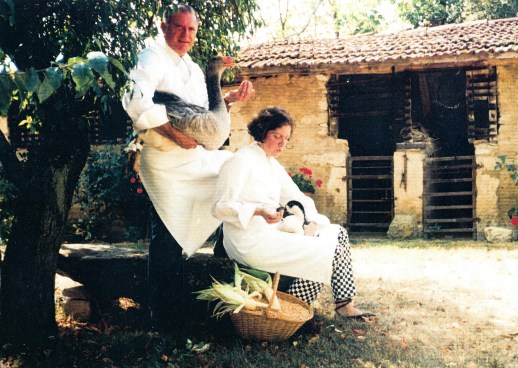It all started…well, in the 1600s, when the real life D’Artagnan, hero of the novel “The Three Musketeers,” was born in Gascony, in the Southwest of France. Known for bravery, chivalry, and sometimes reckless deeds, he is the iconic ancestor to the entire population, who firmly believe they are all descendants of the brash musketeer. They admire his panache, his character, and how he exemplified the beauty of the gesture that the Gascons hold dear. So it comes as no surprise that in the town of Auch, a short walk from a statue of D’Artagnan, Ariane Daguin grew up with big dreams of adventures in far off places.

But first she learned to cook in the kitchen of the two Michelin star Hôtel de France with her father Chef Andre Daguin. And she learned all about foie gras with her grandmother at the famous markets of the region. By the time she was ten, she could debone ducks, render duck fat, prepare terrines and cook the game birds that hunters brought. In Gascony, fine food and wine are just a part of life, something to which every citizen is entitled; hearty wines, foie gras, Armagnac and truffles are simply woven into the fabric of existence. And everyone is involved, not just in the eating and drinking, but in the growing, foraging and cooking. It’s in the blood, as they say.

And then she left. Flew to the United States seeking independence and an academic degree at Columbia University, and fled the family dynasty of at least seven linked generations leaning over the hot stove. She wanted to prove she could do something big, something different, something all her own…something that wasn’t about food.
But destiny has a way of interrupting all your plans.
While studying and working part-time for a New York pâté producer, Ariane was well-placed to recognize the first domestically-raised foie gras when it walked in the door.Her employers declined to go into business with the duck farmers, so Ariane quit her job, quit school, and pooled her very limited financial resources with those of a co-worker. Inspired by her own bravura, she named their new company after D’Artagnan.
The year was 1985. The food world would never be the same.
Ariane was happy to sell foie gras, but she knew that the other parts of the duck were tasty, too. After all, her father was the pioneer chef that seared the first duck breast and served it rare, like a steak. In Gascony, no part of the duck is wasted, so pretty soon Ariane was smoking and curing duck breasts in her apartment, avoiding the NYFD, stirring great pots of duck legs and gizzard confit, and finding markets for everything but the quack.

And it didn’t stop there. Ariane found small-scale farmers raising animals with conscientious care, and marketed their game birds, rabbits, heritage breed pork, buffalo or capons to the chefs of New York City, who were overjoyed to finally have access to these difficult-to-find ingredients. Menus in the four-star restaurants blossomed with these new choices.
Ariane wanted Americans to experience food the way she did growing up, so she partnered only with small, family-owned farms and cooperatives that focused on the welfare of the animals, their impact on the environment and the quality of what they produced, much like the farms she remembered in France. The farmers and ranchers had to adhere to certain protocols, such as: never, ever administer growth hormones or antibiotics; feed animals a clean, natural, and appropriate diet of grasses and grains; allow animals their natural behaviors and space to roam. She built D’Artagnan on the idea that the care taken on the farm can be tasted on the plate. In other words (her own), “A happy chicken is a tasty chicken.”
And yes, she started selling chicken, too; organic chicken before there was an official organic certification program, before the USDA even acknowledged the term. And she added that quintessentially American bird, the turkey; free-range and organic, heritage breed or the original, wild variety that still stalk the forests of the United States.
She made the name of D’Artagnan famous for a different kind of panache, and for providing the freshest, and most consistent all-natural meat, organic poultry and game available.

D’Artagnan’s inception truly influenced the culinary landscape in America, since it coincided with America’s growing interest in gourmet food. Before D’Artagnan, chefs had no consistent resource for beautiful, fresh game, meat and poultry. A whole new era in American cooking was ready to begin.
But once D’Artagnan made these and other previously difficult-to-find products readily available, a whole new era in American cooking began.
As the restaurant revolution took off, home cooks demanded access to the delicious food they had experienced while eating out in the new breed of restaurants. D’Artagnan answered the call by creating an ever-expanding line of retail products. Pâtés, terrines, sausages, bacons, cured meats and other delicious prepared products rolled out, all sporting the jaunty duck logo with the musketeer hat. Organic chicken, heritage breed turkey, wild boar, humanely-raised veal, and more, were all packaged for retail consumption, and the grocery stores loved it. So did their customers.
Ariane continues to anticipate the demands of the palates of American chefs and consumers, offering imported Spanish Mangalica hams, milk-fed porcelet piglets, New Zealand venison, wild mushrooms and hunted Scottish game birds.
Today D’Artagnan stands as a pioneer in a movement that is chock full of buzzwords. Farm-to-table, artisanal, free-range, grass-fed; all of these are in the DNA of the company, because to Ariane that is just the way things should be done. She didn’t set out to change the way Americans eat, but on the way to her destiny, Ariane absolutely did.
